Introduction
In this Head Scratcher, we are going to show you five scenarios/problems from some developing markets in Africa that have similar yet slightly different causes.
Scenario 1: Colour-changing exterior coating in Mauritius
A customer built a luxurious house by the coast in Mauritius, but by the time he had finished the plastering stage, not only was he in a hurry to complete his house, he was beginning to run of money. So instead of the plaster and two coats of sheen that was on the original painting specification, he just applied two coats of a 72% PVC matt coating in a pastel beige/grey colour made up of yellow oxide, organic violet, and carbon black colourants.
In less than three months, some of the panels (mostly in the sun) look like the pictures below. The customer blamed the paint/colourant but what really happened? Hint: the moisture readings in some areas are 30-35 percent.
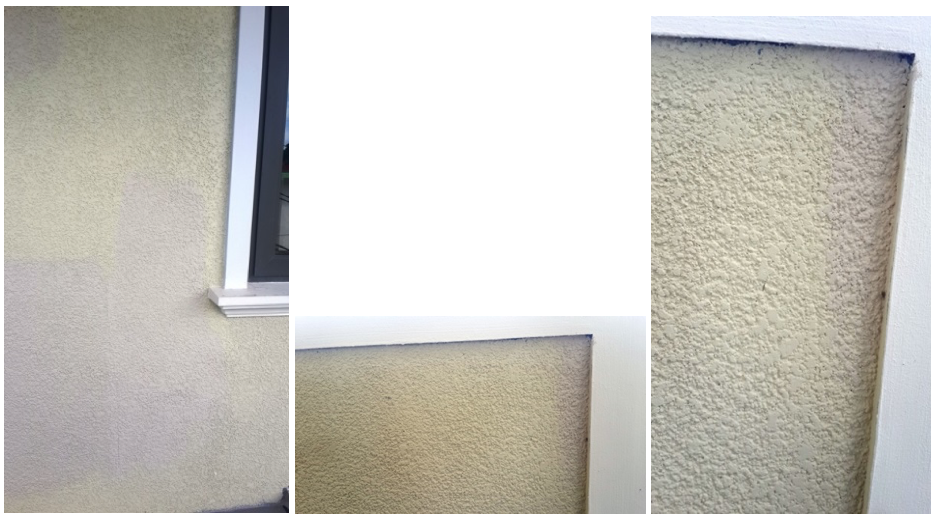
Cause: This is mode 1 of alkali attack. The pebbledash plaster was still damp when the high PVC matt paint was applied. The water carried the alkali salts (Calcium Hydroxide) from the plaster into the paint film in patches, where it was exposed to both light and shade. Further, the Calcium Hydroxide attacked the organic structure of the violet pigment, cleaving to it and making it change colour, leaving only the yellow oxide and carbon black behind.
If the builder would have let the plaster dry for six weeks and/or used the agreed-upon plaster primer, this would not have happened.
Scenario 2: Red oxide house in Kenya
A building contractor built a multi-story house in the very humid seaside city of Mombasa. The paint company told him that he would have to wait six weeks for the plaster to dry, and that he would need scaffolding to paint the very tall walls in the red oxide/white-only pastel sheen colour. However, he only waited two weeks and used ladders to reach the walls.
A few weeks later, the walls looked like the pictures below. The contractor wants the paint company to pay for the repainting but what is the real problem?
Hint: Application and sheen play a role but there is also another issue. Moisture readings in places around the windows are above 20 percent.
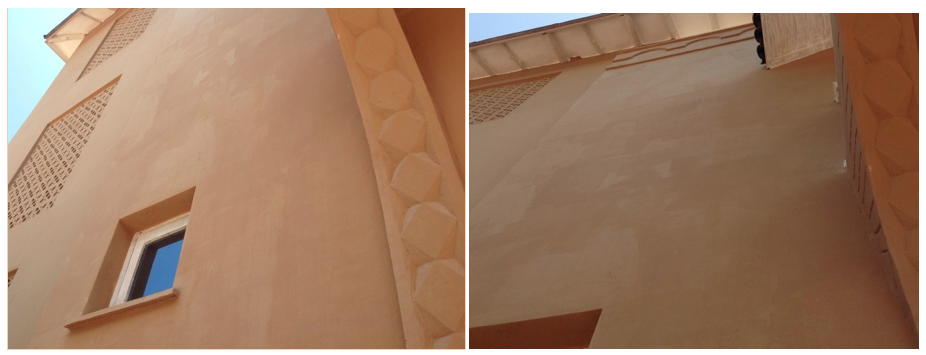
Cause: Although there is evidence of lapping, the wet edge problems were due to the use of ladders instead of scaffolding, plus the plaster was still wet and contained a lot of lime/Calcium Hydroxide which is not very soluble in water. The lime deposited in the paint film as white material, which caused those patches (in both sun-exposed and shaded areas) to look lighter or whiter. This is mode 2 of alkali attack.
Scenario 3: Shopping centre with stone finish in bright colours by a major freeway in Pretoria, RSA
About 15 years ago, a new shopping centre was built by the N1 Freeway in Pretoria East, one of busiest roads in the Southern Hemisphere traversed by many thousands of cars every day. The architects chose a trowel-applied stone finish with 1-2 MM marble chips at 75% PVC on an adhesion-promoted pure acrylic in very bright colours (blues, yellows, and oranges).
For the first four to five years, the colours were ok, but then they started to lighten, as seen in the picture below. The applicator/paint company states that inferior pigments were used to tint the stone finish and they are fading with the sun. But if you look into the film with a magnifying glass, you see a white deposit. What is really happening?
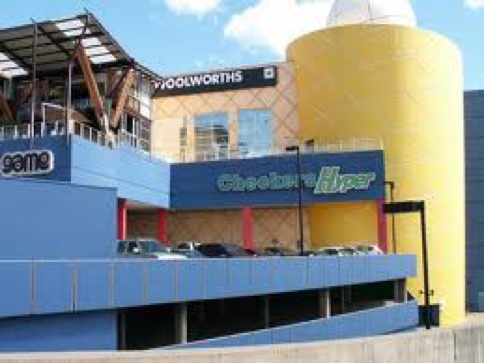
Cause: The stone-filled textured paint was painted on fresh cement which contained Calcium Hydroxide. Small amounts were deposited into the open micro-pore structure of the stone-filled coating, which over time reacted with the carbon dioxide/water from the exhaust fumes of the nearby traffic. This reaction forms white Calcium Carbonate and precipitates in the film, causing the observed white patches. This is mode 3 of alkali attack. The whole building has since been expanded and recoated or tiled.
Scenario 4: Four-Year-Old Houses in Namibia
A housing developer built a complex of cluster houses in Walvis Bay, Namibia. For the main houses, he used a plaster primer and a sheen paint in a pastel blue-grey colour. On the garden walls separating the units, he did not apply plaster primer and used a higher PVC (55-60%) matt paint in the same colour.
For the first two to three years, everything was ok, but then there was a slight ground subsidence and cracks appeared in the boundary walls. Within a year, the walls had white patches and discoloration on them, especially after the water table rose after heavy rain. See the pictures below. What caused the white patches/discoloration and why didn’t it affect the main houses?
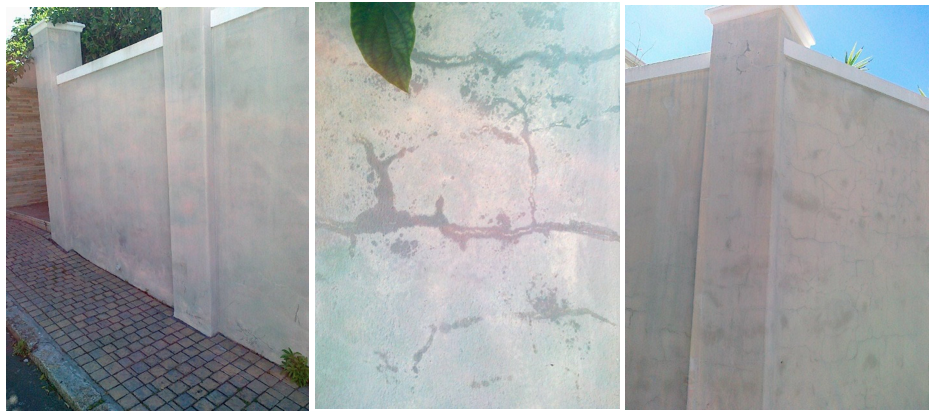
Cause: When the matt coating was painted on the slightly damp wall, its slightly-above-CPVC structure allowed the liquid water to leave the paint film so everything looked normal. When the wall moved with the land subsidence, the matt paint film cracked. This then allowed moisture to enter into the cement and start reacting with the deeper unreacted cement present, producing Calcium Hydroxide by-products, causing a mixture of pigment degradation and white Calcium Hydroxide salt deposits. This is mode 4 of alkali attack.
Scenario 5: Fish warehouse in Beria, Mozambique
A Warehouse owner in Mozambique built a warehouse for Fish storage, on the Docks in the very Humid Sub-Tropical Costal Port of Beria in Mozambique. The Company, who leased the Ware house wanted the whole warehouse painted in their Corporate Colours, which were a Bright/deep Blue based on White and Pthalocyanine Blue tinted from a high-quality Sheen Paint Deep Base. The building was Completed and handed over but in less than 6 Months the leasing Company is complaining that the whole Building is Fading Turning white in patches, see the Pictures Below the Asset owner is Blaming the Paint and the Paint Company is blaming the Tinter Supplier but what went wrong and more importantly how do you fix it?
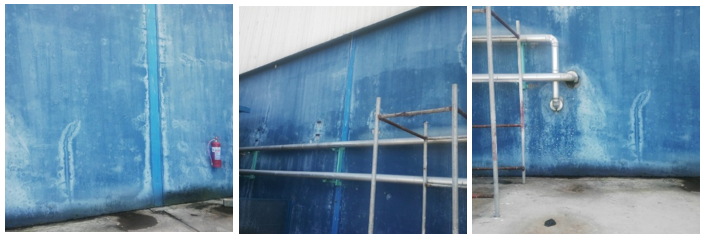
Cause: When the Blue paint was applied the substrate was slightly damp and the Calcium Hydroxide started to attack the Blue pigment in the Paint film leaving it exposed which then reacted with chlorine and Ozone Free Radicals which are present in the salt laden humid air of this area which react together to quickly attack the blue pigment even further/accelerating the break down. This is mode 5 alkali attack and is the rarest form of Alkali attack as it only happens in humid coastal/salt laden atmospheres when Pthalocyanine Blue is present if such a blue is required by the sea than the more inert but far more expensive cobalt blue pigment should be used.
Ready for a head start on your next project?
Prospector has more than 700 starting-point formulations in its materials search engine. Find technical data, request samples, and more.
Search paint and coatings formulations now
The views, opinions and technical analyses presented here are those of the author or advertiser, and are not necessarily those of ULProspector.com or UL Solutions. The appearance of this content in the UL Prospector Knowledge Center does not constitute an endorsement by UL Solutions or its affiliates.
All content is subject to copyright and may not be reproduced without prior authorization from UL Solutions or the content author.
The content has been made available for informational and educational purposes only. While the editors of this site may verify the accuracy of its content from time to time, we assume no responsibility for errors made by the author, editorial staff or any other contributor.
UL Solutions does not make any representations or warranties with respect to the accuracy, applicability, fitness or completeness of the content. UL Solutions does not warrant the performance, effectiveness or applicability of sites listed or linked to in any content.



Very informative, can be a big problem with POS tinting.
Very good report. Alkalinity and efflorescence in plaster is a serious problem.
Which primers should be used in green plasters?
Primers based on antialkali alkid-oil – white spirit?
Primers in water base acrilic dispersions?
Regards
Luis
Thanks Greg you are spot on about POS Colourants in rapidly developing markets where Builders and Painting Contractors take short cuts With Regard to Plaster curing times and don’t use the correct Primers
Luis, in Africa about 30 Years ago we used to use Urethane Modified Alkyds as Binders for Alkali Resistant Primers for Fresh Plasters but we had too many failures, especially when the Builders/Painting Contractors took short cuts and the walls were damp. So here we changed to Masonry Primers based on Solution Styrene Acrylic Polymers in White Spirits at circa 60-65% PVC which work well until cost and VOC became an issue especially when Formulators kept raising the PVC and dropping the solids. People are now either using Solution Acrylics Emulsified in Water or Nano acrylic Polymers in water; both work.
I have a similar problem. An alkali resistant primer was used as a base coating. Then was topcoated with an exterior satin emulsion paint. However, there are white patches all over the building.
Please note that the air conditioning is always on inside. Could this be the cause
Thanks Kwesi -I actually think that there are 3 possible issues :
1. The Air Conditioning leaking it the other side of the wall and Causing Mode 4 Alkali attack
2. The air conditioning Causing a temperature gradient in the wall causing the Cement reaction to be slower and then alkali is released over time
3. Your Alkali resistant primer is too high in PVC and is letting water vapour out but depositing the Calcium Hydroxide Salts in the film causing the patches in the Satin Film
From Experience it could 1 or 2 or even all 3 of the above
All the best
Phil
Good day Mr fill, I want to know what material on paints are responsible for Alkaline resisting properties.
I have been having challenges in this regard.
Thank you.
Thanks Lillian So you are dealing with Saponification or the reaction between the Calcium Hydroxide created in the cement reaction and the COOH groups on the Oil of your Oleo resinous Binder. When I started in the paint Industry 37 years ago, most paint companies in South Africa/Africa used Oleo-resinous binders for their plaster primers for new plaster work and it worked-if (and it’s a big if) the building contractors left the cement to dry and cure for 4-6 weeks (as is done in the UK and most of Europe) but as Africa developed and the building contractors started to take short cuts and not give the plaster the 4-6 weeks for drying and cut it down to 3 then 2 weeks( now sometimes 1 week (and less )), Oleo-Resinous plaster primers began to fail a lot and people, certainly in South Africa began to move away from them first on to TDI Modified Alkyds and then as the plaster drying times got cut even further they started to fail and people started to switch to solution acrylics (mostly styrene acrylics) that have very few almost no groups to saponify also they bind and penetrate extremely well and if formulated correctly “breath” let water vapour (not liquid water) out and are cost effective, easily overcoated with decorative WB and SB Systems. A resin you might have heard of is Pliolite AC80/AC4 -these are 100% solid resins but there are many versions (60-65% solids) made by many producers. This was state of play until about 10-15 years ago when VOC and cost issues started to make themselves felt more, and we started to learn ways of getting water into these resins/systems to reduce costs and increase viscosity.This has become the norm at least in Southern Africa where I mostly consult. But now the moves are towards water borne solution acrylic resins and water based nano polymers (BASF and Dow). Both have these polymer types. Some people feel that they are not as robust as the old systems but are low VOC.
Hopefully this Helps you
All the best
Phil
From: Lilian Maxwell
Sent: Friday, March 1, 2019 8:36 PM
Thank you Mr Fill. Your response has answered some of my questions. Will go back to the laboratory and do some reformulation. Presently we are using Oleoresin and other additives. My coating being solvent borne. Thank you for your swift response.
Dear Lilian
Thank you for your inquiry about how to Improve the alkali resistance of your paint. I presume that you have seen the PPT on Alkali attack and the problems it can cause in the field. There is no really simple answer to your question as a lot will depend on the type of paint that you are making (from a cost/performance point of view) and the substrate to be coated, but to give you some idea of the kinds of factors that are important:
1. Binder Type – I presume that your main problems are with water based paints, not solvent based paints and the rough order from bad to excellent for binder types for alkali resistance (Calcium and Sodium Hydroxide -Calcium is much harsher)
> Worst_________________________________________________________________________Best
> VA Homopolymer, VA Copolymer VA VEOVA Pure Acrylic /Styrene Acrylic VAE
> Low Cost Medium Medium to High
But not all styrene and pure acrylics have exactly the same alkali resistance. Some are better than others. Polymer particle size, water resistance, whether its colloid or surfactant stabilized, is it high or low MFFT–all play a role.
2. Binder level – Normally the higher the amount of binder, the better the performance, but there is a point where adding binder makes no difference.
3. Pigment/extender type and level – Some pigment and filler combinations are much better than others. In some markets, a combination of fine/less fine Calcium Carbonates are used with Platy Talc for better alkali resistance
4. Defoamer, dispersant and thickener type and level can play a big role in both improving and reducing alkali resistance, but in our work, defoamer and thickener types had a bigger Influence than dispersant with urethanes being better than acrylics
Hopefully the above makes Sense to you
All the best
Phil
I have read your post from start to end. Thanks for sharing this informative post with . The problems you mentioned in this post that come in painting during in Africa , are really helpful. Please keep us up to date like this. Thanks for sharing.